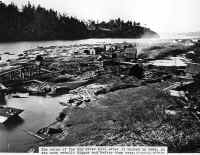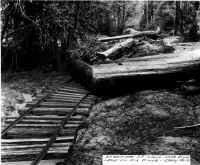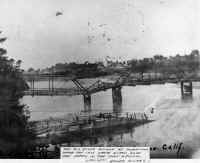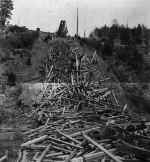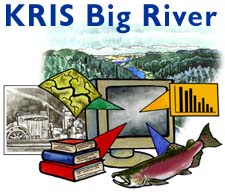Bibliography Background About KRIS
Big River History: Events - floods, storms, shipwrecks
Photos provided courtesy of the Mendocino Historical Society and the Held Poage Memorial Home and Research Library. From the collection of Robert Lee. The Bancroft Library at U.C Berkeley also allowed use of a few select photos of the area from their Watkins collection. Further use of photos must be approved by the Mendocino Historical Society or the Bancroft Library. Click on the images to view at full size.
The following excerpts are from Mendocino City, A daily Journal 1852-1938
by W. Francis Jackson. Mendocino Historical Research, Inc. Copyrighted.
October 17, 1863 Second mill was totally destroyed by fire. (The need for necessary timbers in rebuilding, which commenced immediately following the fire, induced the Company to reserve nearby large trees, the reason Reserve Gulch was so named)
November 27, 1865 Storm Cloud, a schooner, was discovered bottom up on the beach as the day dawned. (She had been driven on shore by heavy seas. The ship was a total loss. Jerome B. Ford and others, including the Company, were its owners)
November 28, 1865 Masts of the schooner Golden State revealed her presence at the bottom of the Bay, it having sunk during the night while at the loading mooring. (She was the second ship destroyed in the storm).
December 16, 1868 End of wharf, located on an island in the Bay, was washed away by rough seas. (In January 1869, a pier and part of the bridge connecting the island to the mainland was also destroyed by the ocean waters)
October 20, 1870 25 buildings destroyed in what has been to date, the largest fire in this community. (The fire began in the St. Nicholas Hotel, northeast corner of Main and Kasten Streets, spreading westward to Heeser Street, burning all in its path)
November 11, 1870 Dearth of water at the mill. (During this period, one lighter each day was taken to Water Spout Gulch two miles upriver, filled with water, then brought down the river to enable the mill to run a few hours each day)
April 18, 1878 Total rainfall for the season was 79.09 inches, as recorded at the mill by superintendent Charles W. Denslow. (Monthly totals were: October 3.09, November 8.73, December 7.21, January 27.49, February 23.66 and March 8.91)
March 5, 1879 The river rose to a height of 25 feet at James Nichols logging camp downriver from the foot of Big Hill. (His logging career was to include 3 logging camps, at Boyles, at Burkes tie camp and the one already mentioned)
March 6, 1879 Men from town were ordered to the bridge by road commissioner, George Switzer, to save it from being destroyed. (A log jam had built up behind its main pier -- trash from extremely high flood waters upriver)
December 19, 1879 Rain gauge revealed the presence of 3.47 inches of precipitation. (This made the season's rainfall total to date at 27.39 inches. The storm's accompanying winds did much damage to fences and roof shingles)
May 24, 1890 79 degree temperature at 9 o'clock am in town at the Central Hotel. (At Sanel, south of Ukiah, the temperature read 115 degrees, and as the Mendocino Beacon reported, "that is where it should be")
December 23, 1892 Fierce storm and its accompanying winds blew down the old school house steeple, also destroyed many wind mills and fences.
Jan 23, 1894 Walter Anderson, manager of the Company's lower ranch, and his helper, Stimulous Loveland, began repairing storm damage caused 2 days earlier. (the cookhouse had to be cleaned, road downstream to other camps repaired and re-opened)
June 16, 1896 Tidal wave struck the coast, with the sea rising and falling in mighty waves, 7 feet beyond its normal level. (the principal was extended itself upriver to the Boom, raising the river by 10 inches, 3 1/2 miles distant)
August 26, 1894 90 degree temperature at noon at the Central House Hotel, according to Stimulous M. Loveland's diary. (He was employed at the company's Lower Ranch where he kept a diary, often recording historical facts)
August 31, 1903 Electrical power was off for the second consecutive night, a forest fire having destroyed its water supply flume. (Flume went up the river from the mill. A 10,000 gallon water tank was installed to forestall similar problems)
February 15, 1904 The river rose 20 feet at the foot of Big Hill when a storm dropped 6.03 inches of rain. (Workers at the Perkins brothers camp near Laguna Creek spent the night on an adjacent hillside, driven there by the rising waters)
January 18, 1906 Seven inches of rain fell in a three day period, raising the river 26 feet at the foot of Big. Hill. (The great rise in the river destroyed the railroad bridge at the mouth of Laguna Creek. Local bridge damaged by escaping logs)
April 18, 1906 Mill heavily damaged by the San Francisco earthquake. (The mill's most prominent feature, the 1,000,000 brick [square] chimney, collapsed. Its bricks had been hauled to the site by Napoleon Bever. The mill's main flywheel also was damaged)
May 5, 1906 Earthquake-damaged bridge opened to the public, its center pier having collapsed during the April 18th tremor. (The new smoke stack for the mill arrived at Little River. It was 70 feet tall when installed)
February 5, 1907 Rainfall total for the past seven days was 16.18 inches. (the river ran so fast that logs in the millpond, the company's gasoline boat, log sawing machinery and floating windlass, all went to sea with the runoff water)
January 20, 1909 January's tot al rainfall to date 18.71 inches. (the ;month's total was 24.38 inches. Its was known that it rained for at least 18 days. Two of them having over 3 inches of rain and tow days at 2 inches. February 1902 had 27.26 inches.)
December 9, 1909 17.22 inches of rain have fallen this season to date, two inches more than has been recorded to this time since we have been recording rainfall totals. (The 9 year average has been 10.91 inches)
August 14, 1910 Fire on the beach destroyed immense piles of driftwood. (At one time, the whole beach was on fire. The fire burned for two days, and cleared it of all longs and debris)
September 6, 1912 Contractor William H. Burke was aided in getting his railroad ties down the river by an usual rainfall, which totaled 4 1/2 inches. (During the summer months, Burke drove ties by aid of a small dam at the Company's Lower Ranch)
June 3, 1912 96 degrees at Burke's railroad tie making camp, and at other locations surrounding town. (Burke's camp, still known by that name, was located one mile upstream from the Little Northfork)
November 6, 1912 Earliest log drive ever recorded occurred when an unusual rain storm dropped 6 inches of rain in less than 36 hours. (This enabled some 25,000 logs to come down the river and into the Boom)
October 3, 1914 J. Relmond Smith's weather report was recorded for the first time in the Mendocino Beacon. September's report recorded the hottest day at 90 degrees. Coldest day at 42 degrees, .46 inches of rainfall, 14 clear days and 16 cloudy)
December 31, 1914 Water rose 35 feet at the Boom during the current storm, and needless to say, the flood created much havoc. (The railroad log dump was severely damages, also the tie dock and cabins used by the rafting crews were affected)
June 19, 1918 Fire destroyed one-half million feet of logs tiered in the river at Ellison's logging camp. (Logs were tiered in the riverbed in preparation for driving. They were piled on top of each other, from bank to bank and to top of same)
February 10, 1919 The lower log jam near Ellison's Logging camp gave way as the river was up from heavy rains. (Logs from Cecil and Charles B. Mallory's logging camps on the Southfork were left stranded at Kelly's Gulch)
April 17, 1920 Season's rainfall total to date, 14.75 inches. (The year's final total was but 15.40 inches, the driest year recorded. In 1918 the total was only 20.25 inches. Other dry years were in 1921/22, 24.28 inches and 1922/23 with 24.32 inches)
July 1, 1920 Mill shutdown for lack of water. (The boilers required 80,000 gallons per day. All water sources had dried, from across the river at the mill to the upriver tributaries, one mile distant. This is between today's rock pit and the New Boom)
July 2, 1920 Lightning storm lasted all day and will into the night, recording 8 lightning strikes surrounding this community. (Flag poles, power line transformers, tall and majestic trees were struck and destroyed by subsequent fires)
October 17, 1924 Shenandoah, the Navy's dirigible, passed over town at an altitude of 500 feet. (A photograph taken from the airship, showing ;the Mendocino Coastline, was published in the January 1926 issue of the National Geographic magazine.)
December 20, 1924 Two inches of rainfall in 12 hours precipitated another log drive for the season. (All 4 logging dams were turned loose, the water breaking out a large log jam at the Lower Ranch. It took 43 minutes to pass a given spot)
September 22, 1931 The great Comptche fire began, commencing at three separate locations on the river (The fire crossed a ridge heading toward Comptche, destroying 10 homes on the way. That community were saved; thousands of acres of timberland burned)
January 13, 1932 Snow blanketed the town nearly 31/2 inches deep. (It was reported as the heaviest since the great fall in the 1880's. It also was reported that this storm brought 18 inches of snow to Orr's Spring. )
May 9, 1932 Company officials filed Affidavits in Superior Court absolving themselves of having started the Comptche fire. (This forest fire had its beginning on Company lands, starting at three separate locations, which became a single fire)
December 10, 1937 Five inches of rain fell in less than 24 hours. (The storm began with a hailstorm at 3:00 o'clock pm, and then it rained in sheets for an hour or so. By nightfall the streams were running full, the river rose 24 feet at Big Hill)
September 20, 1938 One of the two parts of the Benson log raft began breaking up by action of a rough sea. (The Bay was almost covered with logs when the breakup was completed. Logs were also scattered along the coast. 1200 were herded into the river)
Infrastructure - railroads, boats, bridges, etc.
Events - floods, storms, shipwrecks, etc
Logging / Mills - operations and events at mills, logging activities
Also see, Big River Was Dammed (excerpts) and Fish stories from the past
